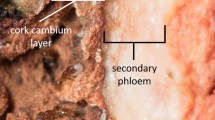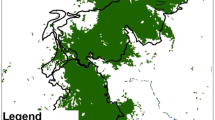Summary
The sociobiology of Leptogenys ocellifera especially its predatory behavior and food recruitment was investigated. Leptogenys binghami and Leptogenys diminuta were observed comparatively.
L. ocellifera: Colony size, nesting sites, and nest emigration. L. ocellifera lives in large colonies of several tens of thousands workers. It nests in existing soil cavities. The nesting site is changed in irregular intervals. According to our results the nest emigration is released by environmental factors.
Trail system. There are several elaborated permanent routes leading from the nest into the surroundings. Those routes can be used continuously day and night over a period of several months. Guard ants are posting along the trails. Mainly in the evening, males were observed on the trails running back and forth. This behavior is interpreted as mating running”. In the peripheral surroundings of the nest the routes may change within few hours or even minutes according to the food supply.
Recruitment trails. The workers leave the nest singly or in groups. When an ant meets a prey animal it returns to the closest frequented trail rubbing its gaster tip on the ground while the sting is intermittendly extruded. The alarm secretion is released from the venom gland. It works as both orientation and recruiting signal and attracts new workers from the trail. No tactile signals are involved in food recruitment. The new workers in their turn intesify the alarm trail. Prey carrying workers lay trails to the nest which recruit further ants. Once the food source is exploited the alarm effect, even on strong trails, would decrease within half an hour. Recruitment trails which have been used over some time may become permanent routes. Along the permanent routes in addition to the recruiting substance an orientation component could be detected which lasts at least over 5 hrs. Its source is still unknown
Predatory behavior. During foraging the workers frequently show digging behavior especially on places with fresh soil. Alarm secretion increases the digging activity. By this method L. ocellifera captures mainly animals which live in the soil, especially termites and earth worms. Other arthropods and snails are also predated. Larger prey objects are hunted and cut into pieces cooperatively. The pieces are transported into the nest by single workers. Killed termites are layed down near or on the trails by the foragers. Such depots are emptied by other workers.
L. binghami and L. diminuta: L. binghami lives in natural earth cavities. It forages singly as a rule. Its main prey animals are termites. The trail secretion is mainly used during nest emigration. This is performed in a fast and well organized way.
L. diminuta nests near the surface of the soil. It is a typical group prdator. The successful scouts lay recruiting trails while returning into the nest. The observed raids contained three to more than hundred workers led only sometimes by the scout. Prey objects (mainly larger arthropods) are hunted and retrieved cooperatively.
Zusammenfassung
Die Soziobiologie von Leptogenys ocellifera, insbesondere Jagdverhalten und Futteralarmierung, wird untersucht. Leptogenys binghami und Leptogenys diminuta werden vergleichend mitbearbeitet. L. ocellifera: Volksstärke, Nestplatz, Nestwechsel. L. ocellifera lebt in individuenreichen Kolonien mit Zehntausenden von Arbeiterinnen. Sie nistet in vorgebildeten Erdlöchern. Der Nestplatz wird in sehr unregelmäßigen Abständen gewechselt. Der Nestwechsel wird nach unseren Befunden exogen ausgelöst.
Das Straßensystem. Vom Nest führen mehrere ausgebaute Dauerstraßen in die Umgebung, die über Monate beibehalten werden können. Sie werden bei Tag und Nacht belaufen und von Wächterinnen bewacht. Auf den Laufrouten patrouillieren vor allem abends Männchen auf und ab, was als „Hochzeitsschwarmlauf” interpretiert wird. Im peripheren Nestbereich werden die Laufrouten zunehmend variabler und können je nach Beuteangebot im Verlauf von Stunden oder sogar Minuten wechseln.
Rekrutierungsspuren. Die Arbeiterinnen laufen einzeln oder in Gruppen aus. Ist ein Tier auf ein Beuteobjekt gestoßen, so kehrt es zu dem nächsten stärker belaufenen Straßenabschnitt zurück, wobei es die Gaster senkt und den Stachel intermittierend herausstreckt und auf dem Boden schleift. Das austretende Giftdrüsensekret hat Orientierungs- und Alarmierungsfunktion und lockt Neulinge von der Straße herbei. Taktile Signale spielen bei der Futteralarmierung keine Rolle. Die Neulinge verstärken ihrerseits die Alarmspur, die von Futterträgerinnen bis ins Nest gelegt wird. Ist die Nahrungsquelle erschöpft, so klingt auch nach intensiver Bespurung der Alarmeffekt innerhalb einer halben Stunde ab. Bei längerer Benutzung können Alarmierungsspuren in Dauerspuren übergehen. An den Dauerspuren ließ sich zeigen, daß neben der Rekrutierungssubstanz auch eine langlebige, über 5 Std haltbare Orientierungskomponente abgegeben wird. Ihre Herkunft ist noch ungeklärt.
Jagdverhalten. Bei der Suche nach Beute graben die Arbeiterinnen häufig, besonders an frischen Erdstellen. Alarmspursekret verstärkt die Grabeaktivität. Durch diese Jagdweise erbeutet L. ocellifera bevorzugt bodenbewohnende Tiere, vor allem Termiten und Regenwürmer. Daneben werden auch andere Arthropoden und Schnecken erjagt. Größere Beutetiere werden gemeinschaftlich überwältigt, zerstückelt und die Teile von Einzeltieren ins Nest transportiert. Getötete Termiten legen die Jägerinnen an oder auf der Straße ab. Andere Nestgenossinnen entleeren disese Depots.
L. binghami und L. diminuta: L. binghami bewohnt ebenfalls natürliche Erdhöhlen. Sie jagt in der Regel einzelh. Ihre Hauptbeutetiere sind Termiten. Das Alarmspursekret wird vor allem beim Nestumzug eingesetzt, der sehr rasch und gut organisiert abläuft.
L. diminuta nistet sehr nahe an der Erdoberfläche. Sie ist eine typische Gruppenjägerin. Die Finderinnen laufen zur Kolonie zurück, wobei sie eine Alarmspur bis ins Nestinnere legen. Die so ausgelösten Raubzüge umfaßten 3 bis über 100 Tiere und wurden nur zum Teil von der Finderin angeführt. Die Beuteobjekte, hauptsächlich größere Arthropoden, werden gemeinschaftlich erjagt und heimtransportiert.
Die Ergebnisse werden im Zusammenhang mit den von Wilson entwickelten Vorstellungen über die Entstehung des Lebenstyps „Treiberameisen” diskutiert.
Similar content being viewed by others
Literatur
Bailey, N.T.J.: On estimating the size of mobile populations from recapture data. Biometrika 38, 293–306 (1951)
Bingham, C.T.: The Fauna of British India, including Ceylon and Burma. Hymenoptera II: Ants and cuckoo wasps. London: Taylor and Frances 1903
Erickson, J.M.: Mark-recapture techniques for population estimates of Pogonomyrmex ant colonies: An evaluation of the 32P-technique. Ann. ent. Soc. Amer. 65, 57–61 (1972)
Fletcher, D.C.J.: The glandular source and social functions of the trail pheromones in two species of ants (Leptogenys). J. Entomol. (A) 46, 27–37 (1971)
Hölldobler, B.: Homing in the harvester ant Pogonomyrmex badius. Science 171, 1149–1151 (1971a)
Hölldobler, B.: Recruitment behavior in Camponotus socius. Z. vergl. Physiol. 75, 123–142 (1971b)
Hölldobler, B., Möglich, M., Maschwitz, U.: Communication by tandem running in the ant Camponotus sericeus. J. comp. Physiol. 90, 105–127 (1974)
Hölldobler, B., Wilson, E.O.: Recruitment trails in the harvester ant Pogonomyrmex badius. Psyche Cambridge 77, 385–399 (1970)
Lindauer, M.: Communication among social bees. Cambridge/Mass.: Harvard University Press 1961
Maschwitz, U., Hölldobler, B., Möglich, M.: Tandemlaufen als Rekrutierungsverhalten bei Bothroponera tesserinoda Forel (Form., Ponerinae). Z. Tierpsychol. 35, 113–123 (1974)
Maschwitz, U., Mühlenberg, M.: Leptogenys ocellifera (Form.). Verhalten auf Dauerspuren. Alarmierung und Beuteeintragen (Freilandaufnahmen). Encyclop. Cinemat., Göttingen, 3–10 (1973)
Maschwitz, U., Tho, Y. P.: Chinone als Wehrsubstanzen bei einigen orientalischen Macrotermitinen Insectes Sociaux 21, 231–233 (1974)
Schneirla, T.C.: Army ants. A study in social organization, H.R. Topoff, ed. San Francisco: Freeman 1971
Szlep-Fessel, R.: The regulatory mechanism in mass foraging and recruitment of soldiers in Pheidole. Insectes Sociaux 17, 233–244 (1970)
Wheeler, W.M.: Ants, their structure, development and behavior. New York: Columbia University Press 1910
Wilson, E.O.: The beginnings of nomadic and group predatory behavior in the ponerine ants. Evolution 12, 24–31 (1958)
Wilson, E.O.: The insect societies. Cambridge/Mass.: Belknap Press of Harvard University Press 1971
Author information
Authors and Affiliations
Additional information
Wir danken der Deutschen Forschungsgemeinschaft, die durch ein Forschungsstipendium diese Untersuchungen ermöglicht hat.
Rights and permissions
About this article
Cite this article
Maschwitz, U., Mühlenberg, M. Zur jagdstrategie einiger orientalicher Leptogenys-arten (Formicidae: Ponerinae). Oecologia 20, 65–83 (1975). https://doi.org/10.1007/BF00364322
Received:
Issue Date:
DOI: https://doi.org/10.1007/BF00364322




